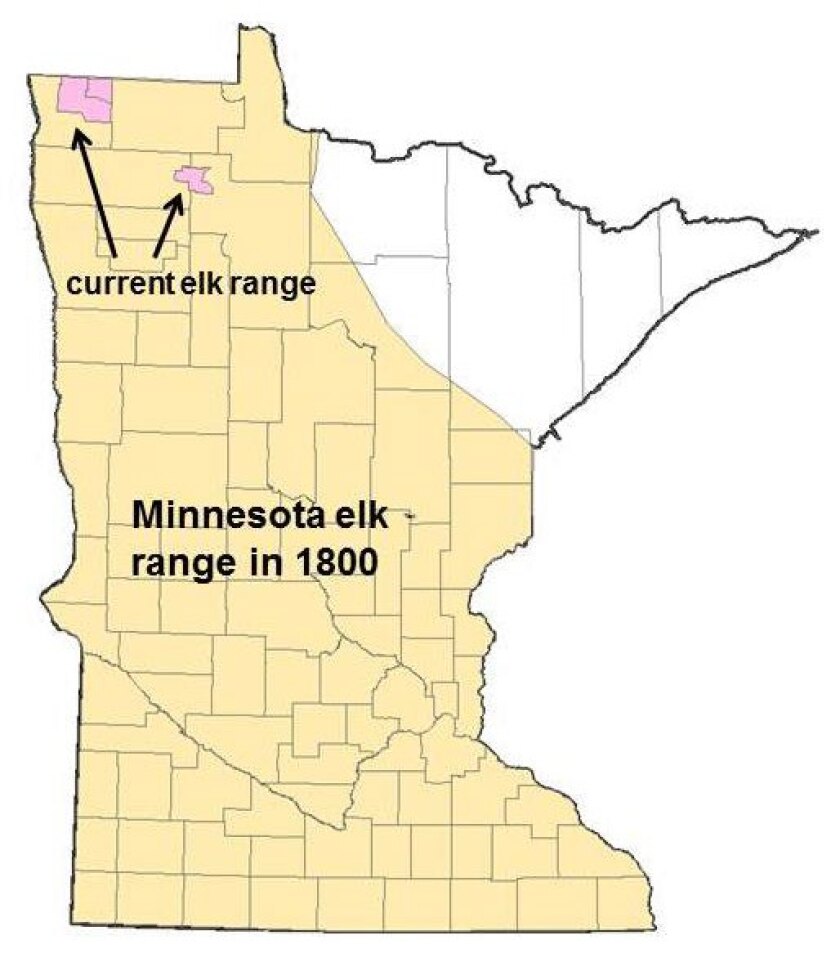The creation of a management plan to expand Minnesota’s elk herds is moving forward.
The current elk herds of northwest Minnesota may have some of the herd picked up and moved to northeast Minnesota on the Fond du Lac Reservation, consistent with the direction and funding provided by the Minnesota Legislature in 2023. It’s a project that’s been kicked around for the last 11 years.
ADVERTISEMENT
The Minnesota DNR is working to support the Fond du Lac Band of Lake Superior Chippewa to restore elk to the Fond du Lac Reservation and surrounding area, including the 1854 Ceded Territory. The management plan seeks to move between 100-150 elk from northwest Minnesota to northeast Minnesota in “small increments over the course of many years.”
The move, which may start in spring 2026, has been slow coming because the elk herds in the northwest are not growing as quickly as DNR would hope, according to Mike Schrage, Fond du Lac wildlife program manager. The DNR reports that the state’s current herd includes 100-150 elk, so this plan would essentially double the state’s population over a period of about a decade.
Members of the public have had opportunities to bring their comments and concerns to the Minnesota Department of Natural Resources about this plan, including a public hearing Monday, Feb. 11, via online video call.
Those supportive of the plan are looking forward to increased recreation opportunities such as hunting the elk and seeing the animal return to lands it once called home.
Members of the agriculture community have been pushing back against the idea of an expanded elk herd because of the issues of destruction and depredation they have been dealing with from the herd in northwest Minnesota. One member of the public commented that they are on a waiting list to be paid compensation for damages they have incurred from elk in northwest Minnesota.
Kaitlyn Root, executive director of the Minnesota State Cattlemen’s Association, commented during the hearing and asked DNR staff what assurances they could give to cattle producers and farmers that this would not adversely affect them. Elk depredation is a chief concern of theirs.

“We are very concerned with what is going to happen when we transfer elk to northeastern Minnesota,” she said. “We feel that this northwestern problem needs to be addressed before creating a new problem in northeastern Minnesota. It’s such a problem that … the Minnesota Department of Agriculture has had to pull from the wolf depredation fund to reimburse elk depredation claims.”
ADVERTISEMENT
During fiscal years 2019–2021, an average of $114,740 per year was paid by the Minnesota Department of Ag in elk damage claims.
The Minnesota Department of Agriculture runs the wolf, deer and elk damage compensation programs that support producers who see loss. While the wolf fund is meant to support a producer who loses an animal to a wolf kill, the elk fund supports a producer who loses stored forage or suffers significant crop or fence damage. This year, the elk fund was maxed out and producers are on hold until further funding is approved by the state.
Root recognized that the DNR wants to hear from them, but she wanted to hear from the DNR about what they planned to do about the expected problem. She suggested that public land could be a place where food plots could be used to attract these animals away from farmland.
LaSharr commented that some food plots are used, but the reason that some of these public lands are public lands is because they are unsuitable for farming.
One assurance that Thomas Howes, natural resources manager for the Fond du Lac Reservation, offered was that they plan to have six staff managing the landscape for elk, including brushing and creating wildlife openings, along with logging that they hope attracts the elk to stay put.
“That’s absolutely our goal, is to make sure that they just stay put out in these large tracts of public land,” he said.
The Fond du Lac Reservation is 100,000 acres in size.
ADVERTISEMENT
Kelsie LaSharr, Minnesota DNR elk coordinator, said they are watching closely the amount of damage that takes place. The DNR recently completed and shared a “cervid damage report” with the Minnesota Legislature to show the level of damage on the landscape.
In response, some Minnesota senators have put forth a new bill, , seeking appropriations of $2.5 million each in 2026 and 2027 for wolf damage and another $2.5 million each year for elk damage.

LaSharr said in the coming months, the DNR wants to work with stakeholders such as cattle producers to hear what tools they should have in mind to be prepared for what issues may arise.
“If we’re concerned about stored forage, all right, let’s get some temporary, portable fences that we can, you know, hand out to producers when they’re having an issue and they have to move on. Maybe they get moved to the next producer,” LaSharr said. “So we can sort of work through these things, but we do need help in coming up with these solutions, because we can’t do it alone.”
While the goal of the Fond du Lac Tribe is to return elk to the landscape and keep the animals there, Schrage shared that in his eyes, this reintroduction would be viewed as a success if the elk make a return to the landscape across the state, in their original range, and the public acceptance of that growth would continue to grow, too.
To share comments on the proposed project, there remains an in-person comment opportunity from 6 to 8 p.m. Thursday, Feb. 13, at the Fond du Lac Tribal and Community College, Room 195; 2101 14th St.; Cloquet, Minnesota. You can also fill out to help shape a draft management plan by visiting the Minnesota DNR’s elk page at












